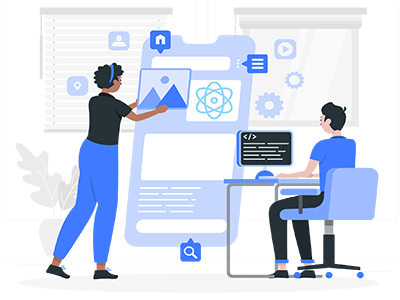AI in software development: Key opportunities + challenges
Artificial Intelligence (AI) has revolutionized many industries, and software development is no exception. Over the past few years, the introduction of AI into the development lifecycle has drastically altered how software is created, tested, and maintained. From automating repetitive tasks to enabling advanced predictive models, AI offers numerous benefits. However, integrating AI into software development also presents challenges, particularly in areas such as decision-making, ethics, and skill requirements.
This article discusses the main opportunities that AI brings to software development and addresses the challenges that teams and organizations must manage when incorporating AI technologies into their workflows.
Key Opportunities of AI in Software Development
Key opportunities of AI in software development include automating routine tasks, improving code quality and security, enhancing project management through predictive analytics, and providing intelligent assistance for faster, more efficient development.
1. Automating Routine Tasks
AI can significantly reduce the time spent on repetitive and mundane tasks within the software development lifecycle. For example, tasks such as code generation, bug detection, and testing can be automated using AI-powered tools. These tools are capable of reviewing code, identifying issues, and even generating suggestions to improve it. The automation of these tasks not only increases efficiency but also allows developers to focus on more complex, creative problem-solving.
Tools like AI-based code completion (e.g., GitHub Copilot) and automatic bug-fixing systems are already in use in several organizations, helping to speed up development cycles and reduce human errors. AI can also help with continuous integration and continuous delivery (CI/CD) pipelines, automating deployment and testing procedures in the process.
2. Enhanced Code Quality and Security
AI can also be leveraged to enhance code quality and ensure the security of software systems. Machine learning models can analyze large codebases, detect security vulnerabilities, and even predict where potential issues might arise in the future. By applying AI algorithms to scan for bugs, security flaws, and performance bottlenecks, teams can improve software reliability.
AI-powered tools can also assist in improving code quality by reviewing existing code and suggesting changes that align with best practices. These tools can point out areas where the code might be prone to errors, reducing technical debt and ensuring long-term maintainability.
3. Predictive Analytics for Better Project Management
In software development, the ability to predict potential risks and delays is crucial for effective project management. AI-powered tools can analyze historical data from previous projects to forecast the likelihood of issues that could arise during development. This could include predicting when tasks might be delayed, identifying resource bottlenecks, or forecasting how long a specific task will take to complete.
AI systems can also help manage the allocation of resources by analyzing workload, team capacity, and project requirements. This allows for smarter decision-making, ensuring that developers are utilized efficiently and deadlines are met consistently.
4. Improving Test Automation
Testing is one of the most time-consuming aspects of software development. AI can drastically improve test automation by helping teams create smarter test suites. Machine learning algorithms can generate test cases based on existing code, predict potential points of failure, and even simulate user interactions to ensure that software behaves as expected.
By utilizing AI for testing, development teams can reduce the time spent on manual test execution and the debugging process. AI can also predict which parts of the application are more likely to have issues based on patterns and historical data, allowing teams to focus their attention on the most critical areas first. Custom AI development can create bespoke testing solutions, further enhancing test coverage for unique application architectures and requirements.
5. Intelligent Assistance for Developers
AI-powered tools can act as intelligent assistants, helping developers by providing code suggestions, identifying bugs, and improving their workflow. These tools can integrate into IDEs (Integrated Development Environments) to assist developers during the coding process. By offering real-time feedback, AI can help developers avoid mistakes, follow best practices, and accelerate the development process.
Some tools also help with code documentation, automatically generating documentation based on the code written, reducing the burden on developers to document everything manually.
6. Faster and Smarter Decision-Making
AI can assist in making faster, data-driven decisions during full cycle software development processes. Machine learning algorithms can analyze large datasets, providing insights that inform critical decisions such as which technology stack to choose, what kind of architecture to build, or how to allocate resources effectively.
AI can also analyze user behavior and feedback from the software being developed to help developers adjust features or functionality in real time. This means that software can be developed with more precision, reducing the likelihood of launching a product that does not meet user expectations or business needs.
Key Challenges of AI in Software Development
Key challenges of AI in software development include ethical concerns, data privacy issues, skill gaps, integration complexities, and the need for human oversight to avoid bias and ensure security.
1. Lack of Human Oversight and Bias
One of the major concerns surrounding the integration of AI in software development is the lack of human oversight in critical decision-making processes. AI algorithms are only as good as the data they are trained on. If this data contains bias, the AI can perpetuate those biases in the software it helps create. This can lead to unintended consequences, such as the inclusion of discriminatory patterns in software products, or poor outcomes when AI-driven systems make decisions without sufficient human intervention.
For example, in automated code reviews, AI might inadvertently overlook certain coding practices or flag non-standard but perfectly valid implementations. It may also produce security recommendations that are not tailored to the specific project’s needs. To avoid these issues, human oversight is essential, especially when it comes to reviewing the decisions made by AI systems.
2. Data Privacy and Security Concerns
As AI systems become more involved in software development, the need for handling sensitive data responsibly increases. AI models rely on large datasets, and in many cases, this data includes user data or proprietary information. Handling this data securely and ensuring privacy compliance is critical, especially with regulations like GDPR and CCPA.
If AI-driven systems are not properly secured, they may expose sensitive information or be vulnerable to cyberattacks. This is particularly concerning for AI-driven tools that analyze source code, as any compromise could result in significant risks to intellectual property and security.
3. Complexity and Skill Gaps
Despite the advancements in AI, the technology is still evolving, and not all developers have the skills required to fully leverage AI in their projects. AI tools can be complex to integrate, and a lack of understanding of how these tools work can limit their effectiveness.
Organizations may need to invest in training their development teams on AI techniques and technologies, and there is a potential risk that teams may struggle to adopt new AI systems if they lack the expertise. Additionally, since AI systems are continuously evolving, software teams must stay updated on the latest trends and techniques to fully benefit from the technology.
4. Integration with Existing Systems
Integrating AI into existing development processes and tools can be a challenge. AI-powered tools must often interact with legacy systems or be incorporated into established workflows. In many cases, this requires significant effort to ensure compatibility and smooth operation.
AI’s potential to disrupt existing workflows is both a strength and a weakness. While AI can automate many processes, it often requires an initial investment of time and resources to ensure that it works effectively within the larger software development ecosystem. Moreover, adding AI-based tools may lead to unexpected results or introduce bugs that weren’t anticipated during the initial integration.
5. Ethical Implications
As AI continues to play a larger role in software development, ethical considerations must be taken into account. AI systems can inadvertently make decisions that are not aligned with ethical standards or societal norms. In areas such as AI-driven testing or AI-generated code, there is a risk that these tools may promote practices that could harm users or violate ethical guidelines.
For instance, AI models could be used to generate code that is efficient but potentially harmful in terms of privacy or security. Developers must therefore ensure that AI is used responsibly and that ethical standards are followed when utilizing these technologies.
Conclusion
AI is transforming software development in remarkable ways. From automating tasks to enhancing code quality, predicting risks, and providing intelligent assistance, the opportunities AI presents are vast. However, integrating AI into the development process is not without its challenges. Ethical concerns, data privacy issues, skill gaps, and the need for human oversight all present obstacles that developers and organizations must overcome.
In the coming years, as AI continues to evolve, we can expect its role in software development to expand further, offering even more advanced capabilities and efficiencies. To fully capitalize on these opportunities, software development teams will need to carefully manage the challenges and ensure that they implement AI in ways that are both effective and responsible.






